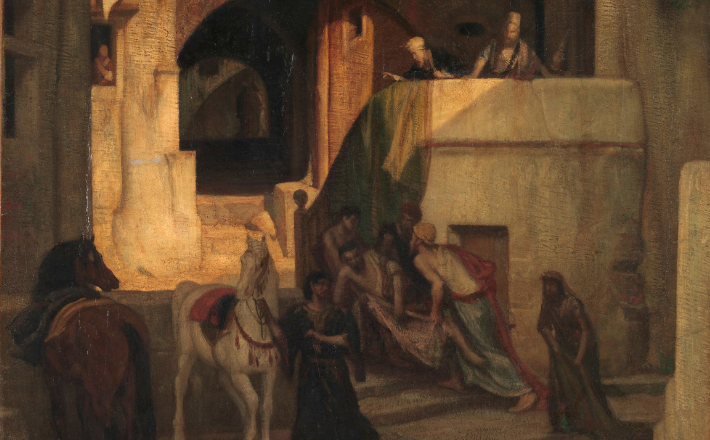Commentary on Amos 7:7-17
The prophetic books are often divided into two categories. The books of Isaiah, Jeremiah, and Ezekiel are considered the Major Prophets, and the remaining twelve books (Hosea, Joel, Amos, Obadiah, Jonah, Micah, Nahum, Habakkuk, Zephaniah, Haggai, Zechariah, and Malachi) are designated as the Minor Prophets. This nomenclature is a bit misleading because these monikers do not indicate the importance of one collection of books relative to the other. The designation has everything to do with the physical size of the books. The books of Isaiah, Jeremiah, and Ezekiel are long, and their length would have required more papyrus or parchment scrolls to produce them. The books of the Minor Prophets are simply shorter than the Major Prophets. Importantly, in many Christian traditions, the Minor Prophets are also referred to as the Book of the Twelve.
The book of Amos is found among the Book of the Twelve. Amos has four major sections: superscription (1:1), oracles against the nations (1:2–2:16), oracles against Israel (3–6), and visions (7–9).
The superscription is important because it includes a description of Amos and establishes the historical setting for the book’s contents. Amos is a shepherd from the southern region of Tekoa, who prophesied regarding the people of Israel (northern region) during the reigns of King Uzziah and King Jeroboam. As a shepherd, Amos responds to a call to prophetic ministry from obscurity. Unlike prophets who were often already part of the elite inner circle of the king, Amos will not only speak to the northern kingdom from the southern kingdom, but his voice will travel to the palace from the literal heartland of Tekoa. In modern vernacular, as a prophet, Amos will “punch above his weight class.”
The second and third parts of the book of Amos include a series of oracles. Within the prophetic material, an oracle is a message from God delivered by some intermediary. When a prophet delivers an oracle, it tends to carry a negative message. While many oracles are directed to foreign nations (for example, Isaiah 31 and Nahum 1 contain oracles against the peoples of Babylon and Nineveh, respectively), biblical prophets also delivered oracles against Israel and Judah. For example, the prophet Ezekiel declares an oracle concerning “the prince in Jerusalem and all the house of Israel in it” (Ezekiel 12:10, New Revised Standard Version), and the prophet Jeremiah warns of and laments the destruction of Jerusalem by the Babylonians (Jeremiah 4:5–22; 8:18–9.26).
Amos 7 contains warnings against Israel in the form of three vision-oracles. The Lord God shows Amos a vision of locusts (verses 1–3), a devouring fire (verses 4–6), and a plumb line (verses 7–9). Each of the three vision-oracles builds to the dreaded conclusion that Israel will be destroyed. In the remaining verses (verses 10–17), the priest Amaziah reports Amos’s proclamations as conspiratorial toward King Jeroboam of Israel, and Amos responds with a personal judgment upon Amaziah and the reiteration of Israel’s pending exile.
The Hebrew word ‘anakh is often rendered as “plumb line” in English translations of the Bible. The biblical writers paint a picture of the Lord God using a plumb line to measure the integrity of Israel. In the same way a modern mason might measure the structural integrity of a wall, the Lord God measures the spiritual integrity of the people of Israel. In this third vision-oracle, the Lord God explains that, as a result of the plumb-line measure, Israel will “be made desolate, and the sanctuaries of Israel shall be laid waste, and I will rise against the house of Jeroboam with the sword” (verse 9). Conquest, destruction, and death are coming to Israel.
Commentary
Undoubtedly, most readers pay great attention to the plumb-line vision-oracle because it foreshadows the Babylonian exile. Modern readers tend to read this passage with great attention to the fact that Israel did not meet the Lord God’s expectations. This passage is interpreted as an admonition for faithful and righteous living to avoid divine punishment. Readers focus on measuring but give little regard to the wall being measured. This reading strategy may distance believers from the understanding that they are the wall being measured.
Like walls that have endured over time, as humans go through life, we may lose our steadiness. In truth, we are not always consistent in our faith practices. We live through major disappointments that challenge our faith. Our hope may be built on a firm foundation, but over time, we may experience our hope “leaning” unsteadily to one side or another. Over time, our spiritual houses may weaken and become less precise.
A wall may erode and get out of alignment for many reasons. A settling foundation is a major reason why a wall or building structure may be out of alignment. Anyone who has spent any time in an older home has walked over an uneven or creaky floor, applied extra pressure to open or close sticking doors, noticed cracked or bowed walls, or repositioned loose bricks on fireplaces or stairs. “Oh, you know how these old houses are. That is a function of settling.” Hearing that explanation, we accept the quirks of the old home and do not give it much more attention … until the evidence of the settling home becomes so pronounced that we must take action.
When a visitor trips on uneven floors, when the ceiling collapses because of a crack in the wall, or when someone suffers from a health condition due to mold growth precipitated by missing bricks, we call a professional to correct the structural damage and preserve the integrity of the home. The building professional assesses the damage and begins the work of fixing the problem before it gets any worse. And that professional will usually offer some advice about the maintenance of the home to avoid future problems.
So it is with our spiritual walls. This Amos text reminds modern readers of the need for maintenance to preserve the integrity of our spiritual foundation. Before the Lord God shows up with a plumb line, there are some things we can do to realign and maintain the integrity of our spiritual walls. When we notice cracks in our foundation, uneven floors, or misalignment in our relationship with the Divine, we can consider (re)instituting daily prayer and meditation, engaging in practices of love and gratitude, and attending to the care of our neighbors, among other correctives for modern believers.


July 13, 2025